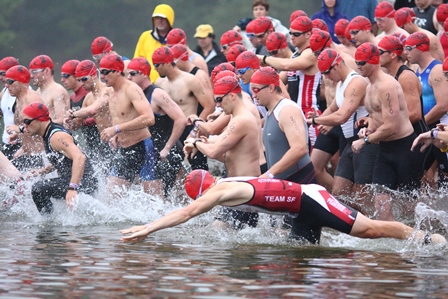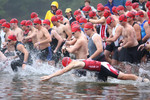Designing A Multisport Pacing Strategy
Posted by matt russ on 22nd Apr 2016
By Coach Matt Russ
 Athletes often contemplate what the “right” or “correct” pace should be for
a particular multisport distance. Designing and implementing a race
pacing strategy can be challenging as pacing is highly individualized, and
there are a variety of methods and ways to approach pacing. In amateur
(draft-illegal) multisport events, each leg should be a relatively consistent
effort from point A to B. In the absence of drafting and variable bike speeds,
you are essentially racing the clock and not the other athletes around you.
There are no jumps, gaps to close, sprints, or other tactics as present in ITU
(draft-legal) triathlon and duathlon. Many races utilize time trial starts or
multiple waves in which it is difficult to even determine who you are racing
against, or what their current position is. For this reason, the smart athlete
stays primarily focused on their individual performance versus that of the
competition.
Athletes often contemplate what the “right” or “correct” pace should be for
a particular multisport distance. Designing and implementing a race
pacing strategy can be challenging as pacing is highly individualized, and
there are a variety of methods and ways to approach pacing. In amateur
(draft-illegal) multisport events, each leg should be a relatively consistent
effort from point A to B. In the absence of drafting and variable bike speeds,
you are essentially racing the clock and not the other athletes around you.
There are no jumps, gaps to close, sprints, or other tactics as present in ITU
(draft-legal) triathlon and duathlon. Many races utilize time trial starts or
multiple waves in which it is difficult to even determine who you are racing
against, or what their current position is. For this reason, the smart athlete
stays primarily focused on their individual performance versus that of the
competition.
Visualizing and racing your event as a time trial also helps you avoid getting pulled off your strategy by external stimuli (ex. chasing other athletes) and keeps you internally focused on your own performance metrics. Now that you are concentrating on getting from start to finish as quickly as possible, the next step is determining your “redline,” or what your most efficient pace for each leg will be. Notice I wrote “each leg.” The swim affects the bike, which affects the run as you may have discovered the hard way. Your goal is not to attempt a PR for each distance, but race the pace that will support your best time overall. Above or below this redline is a less efficient (slower) race. Governing your redline pace for each leg should pull the fastest possible time out of you on race day.
There are a variety of devices and processes you may use to monitor pacing and efficiency. These include…
The best pacing strategy is proactive and real time, not reactive. For instance, I do not recommend using mile splits to pace the run unless you are very familiar with your performance for each mile of the run course, or it is very flat. Using a mile split means you are reacting to the pace of the previous mile, and the previous mile’s terrain, to dictate pace for the proceeding mile (do not count on each mile marker being accurate either). Your pacing is always a mile behind and not in sync with the course elevation. This may lead to a more variable pace which is similar to doing intervals. A sustained, even effort uses less energy. Real-time pacing metrics include heart rate, power, perceived exertion, or speed / pace using a GPS or other device. Like mile splits, speed on the bike may not lead to the most efficient pacing strategy. Bike speed is highly variable and affected by even slight variations in terrain (false flats), headwinds, and athlete positioning. I find the athlete is more likely to get pulled off an effective strategy using speed, especially on a rolling to hilly course, as they try to maintain a speed.
Use of a heart rate monitor and/or power meter requires an intermediate to advanced level of knowledge. Some athletes find these devices distracting or overly complicated. In order to use them effectively, you must determine accurate performance parameters or zones and pace according to them. This will require testing, either in the field or under the direction of knowledgeable coach or exercise physiologist. These tests may include functional threshold power or anaerobic/lactate thresholds. Bear in mind that any test only tests fitness on a particular day at a particular time. In order to get a more accurate “big” picture, it is necessary to also analyze and confirm the tests with training and race data. By breaking performance up into zones it is easier to target a particular fitness substrate in both training and racing. These devices are by no means perfect, however. For instance, heart rate is affected by a variety of external and internal factors and can vary with heat, humidity, and even stress levels. The more complex a device is, the more likely a technical error or malfunction is to occur, and you have to be able to race and pace well even when a device stops working. However, these devices do give objective and real-time performance feedback, and allow the athlete to more accurately dial in and adhere to a pacing strategy.
The swim obviously does not allow any pacing method beyond perceived exertion. Your pace in the pool may not be the same as open water swimming which involves sighting, currents, waves, wetsuits, and, of course, other athletes. I recommend at least several open water swims or bricks prior to a race, on the race course itself if possible. This will give you a better idea of what time to expect and how to pace yourself for the distance in open water and how your swim time will be affected by the conditions.
Most athletes make their pacing mistakes on the bike and subsequently pay for it post-T2. It is easy to get over-stimulated and over-pace the bike. You are still relatively fresh, stimulated, feeling good, and have a sensation of speed. It is tempting to chase other athletes down. Pacing the run may in fact be a bit more intuitive to internally monitor over the bike. When considering your pace on the bike, evaluate these three things…
A sprint or Olympic race will likely be near anaerobic threshold, but even this is not written in stone by any means, and you must train at these intensities in order to race them. A beginner athlete will spend considerably more time on the bike course compared to an elite athlete, and will have to adjust intensity levels accordingly. You have to choose the right pace for your fitness level. If you have not performed many race-paced, sub-threshold bike work outs, do not expect to be able to obtain this level of performance on race day- and run fast off the bike. How do you determine what your bike pace will be? The best way is predicated by your known performance. Race data is some of the most useful information an athlete can obtain and analyze. Each race should be a learning experience and help you dial in your pacing. Race-paced bricks or race simulations also help dial in where you need to pace on race day. Concentrate on smooth power delivery, effort, and a steady cadence. It is far preferable to test your redline and thresholds during a work out versus experimenting on race day. Your cadence on the bike is not necessarily a metric used to pace, but helps you maintain efficiency based on your optimal cadence.
Coming off the bike your muscles have been firing hard, at a high rate, and in a certain pattern, and must now quickly make a transition to a different one. It takes time for the blood that has pooled in certain muscle groups to be redirected to those used in during the run. Do not expect your first 400 meters to be your fastest and you should allow for an acclimation period coming out of T2. Your pace off the bike should be predicted by, well, your pace off the bike. Again, use race data, work outs, and key bricks as means to determine where heart rate, or pace and perceived exertion should be. The more you race, the easier and more accurate this should become. Again, remember that a variable effort (ex. attempting to hold pace uphill) requires a lot more energy, and takes more out of you, over a consistent effort. Your speed and pace should ebb and flow with the terrain as your effort and metrics stay fairly even; save the over the top anaerobic efforts for your final sprint to the finish. If you find that your breathing is no longer rhythmic and you must slow your pace to catch your breath, you are in oxygen debt. Debts have to be paid back and you do so by slowing down to recover.
You may be able to shave a significant amount of time by simply determining and executing a more efficient pacing strategy. Even the best laid plans are useless if they are not adhered to. You must have the discipline to stay focused on your own race, monitor your performance metrics, and carry out your plan. The stimulation and excitement of race day will pull an extra “x” percent out of athletes. Even the best pacing strategy may need to be slightly adaptable on race day. Pacing is not an exact science as it is affected by too many variables to be exactly precise. But, if you have a good idea of what your performance capabilities are going into your race, you can more accurately pace yourself; and, be pleasantly surprised by the extra performance race day brings to the table.
Matt Russ has coached and trained athletes up to the professional level, domestically and internationally, for over 20 years. He currently holds the highest level of licensing by both USA Triathlon and USA Cycling, and is a licensed USA Track and Field Coach. Matt is Head Coach and owner of The Sport Factory, and coaches athletes of all levels full time. He is also free lance author and his articles are regularly featured in a variety of magazines and websites. Visit www.sportfactory.com for more information or email him at coachmatt@sportfactory.com


